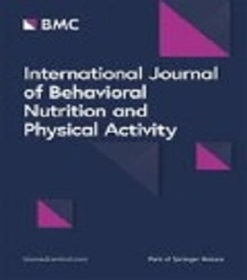Longitudinal associations of diurnal rest-activity rhythms with fatigue, insomnia, and health-related quality of life in survivors of colorectal cancer up to 5 years post-treatment
IF 5.6
1区 医学
Q1 NUTRITION & DIETETICS
International Journal of Behavioral Nutrition and Physical Activity
Pub Date : 2024-05-02
DOI:10.1186/s12966-024-01601-x
引用次数: 0
Abstract
There is a growing population of survivors of colorectal cancer (CRC). Fatigue and insomnia are common symptoms after CRC, negatively influencing health-related quality of life (HRQoL). Besides increasing physical activity and decreasing sedentary behavior, the timing and patterns of physical activity and rest over the 24-h day (i.e. diurnal rest-activity rhythms) could also play a role in alleviating these symptoms and improving HRQoL. We investigated longitudinal associations of the diurnal rest-activity rhythm (RAR) with fatigue, insomnia, and HRQoL in survivors of CRC. In a prospective cohort study among survivors of stage I-III CRC, 5 repeated measurements were performed from 6 weeks up to 5 years post-treatment. Parameters of RAR, including mesor, amplitude, acrophase, circadian quotient, dichotomy index, and 24-h autocorrelation coefficient, were assessed by a custom MATLAB program using data from tri-axial accelerometers worn on the upper thigh for 7 consecutive days. Fatigue, insomnia, and HRQoL were measured by validated questionnaires. Confounder-adjusted linear mixed models were applied to analyze longitudinal associations of RAR with fatigue, insomnia, and HRQoL from 6 weeks until 5 years post-treatment. Additionally, intra-individual and inter-individual associations over time were separated. Data were available from 289 survivors of CRC. All RAR parameters except for 24-h autocorrelation increased from 6 weeks to 6 months post-treatment, after which they remained relatively stable. A higher mesor, amplitude, circadian quotient, dichotomy index, and 24-h autocorrelation were statistically significantly associated with less fatigue and better HRQoL over time. A higher amplitude and circadian quotient were associated with lower insomnia. Most of these associations appeared driven by both within-person changes over time and between-person differences in RAR parameters. No significant associations were observed for acrophase. In the first five years after CRC treatment, adhering to a generally more active (mesor) and consistent (24-h autocorrelation) RAR, with a pronounced peak activity (amplitude) and a marked difference between daytime and nighttime activity (dichotomy index) was found to be associated with lower fatigue, lower insomnia, and a better HRQoL. Future intervention studies are needed to investigate if restoring RAR among survivors of CRC could help to alleviate symptoms of fatigue and insomnia while enhancing their HRQoL. EnCoRe study NL6904 ( https://www.onderzoekmetmensen.nl/ ).结直肠癌幸存者昼夜休息-活动节奏与疲劳、失眠和治疗后 5 年健康相关生活质量的纵向关系
结肠直肠癌(CRC)的幸存者越来越多。疲劳和失眠是结直肠癌术后的常见症状,对健康相关的生活质量(HRQoL)有负面影响。除了增加体育锻炼和减少久坐行为外,一天 24 小时中体育锻炼和休息的时间和模式(即昼夜休息-活动节奏)也可在缓解这些症状和改善 HRQoL 方面发挥作用。我们研究了昼间休息-活动节律(RAR)与 CRC 幸存者的疲劳、失眠和 HRQoL 的纵向关系。在一项针对 I-III 期 CRC 幸存者的前瞻性队列研究中,从治疗后 6 周到 5 年,共进行了 5 次重复测量。通过定制的 MATLAB 程序,使用连续 7 天佩戴在大腿上部的三轴加速度计的数据,评估了 RAR 的参数,包括中位数、振幅、阶相、昼夜商、二分法指数和 24 小时自相关系数。疲劳、失眠和 HRQoL 通过有效问卷进行测量。应用混杂因素调整线性混合模型分析了 RAR 与疲劳、失眠和 HRQoL 在治疗后 6 周至 5 年间的纵向关系。此外,还对随时间变化的个体内和个体间关联进行了分离。研究获得了 289 名 CRC 幸存者的数据。治疗后 6 周至 6 个月期间,除 24 小时自相关性外,所有 RAR 参数均有所增加,之后保持相对稳定。随着时间的推移,较高的中位数、振幅、昼夜商数、二分法指数和 24 小时自相关性与较少的疲劳和较好的 HRQoL 有显著的统计学相关性。振幅和昼夜商越高,失眠越少。这些关联中的大多数似乎都是由 RAR 参数随时间发生的人内变化和人际差异造成的。在昼夜相位方面没有观察到明显的关联。研究发现,在 CRC 治疗后的头 5 年中,坚持总体上更活跃(mesor)、更一致(24 小时自相关)的 RAR,具有明显的活动峰值(振幅)和明显的昼夜活动差异(二分法指数),与疲劳程度降低、失眠程度降低和更好的 HRQoL 有关。今后需要开展干预研究,探讨恢复 CRC 幸存者的 RAR 是否有助于缓解疲劳和失眠症状,同时提高他们的 HRQoL。EnCoRe研究NL6904 ( https://www.onderzoekmetmensen.nl/ )。
本文章由计算机程序翻译,如有差异,请以英文原文为准。
求助全文
约1分钟内获得全文
求助全文
来源期刊
CiteScore
13.80
自引率
3.40%
发文量
138
审稿时长
4-8 weeks
期刊介绍:
International Journal of Behavioral Nutrition and Physical Activity (IJBNPA) is an open access, peer-reviewed journal offering high quality articles, rapid publication and wide diffusion in the public domain.
IJBNPA is devoted to furthering the understanding of the behavioral aspects of diet and physical activity and is unique in its inclusion of multiple levels of analysis, including populations, groups and individuals and its inclusion of epidemiology, and behavioral, theoretical and measurement research areas.

 求助内容:
求助内容: 应助结果提醒方式:
应助结果提醒方式:


